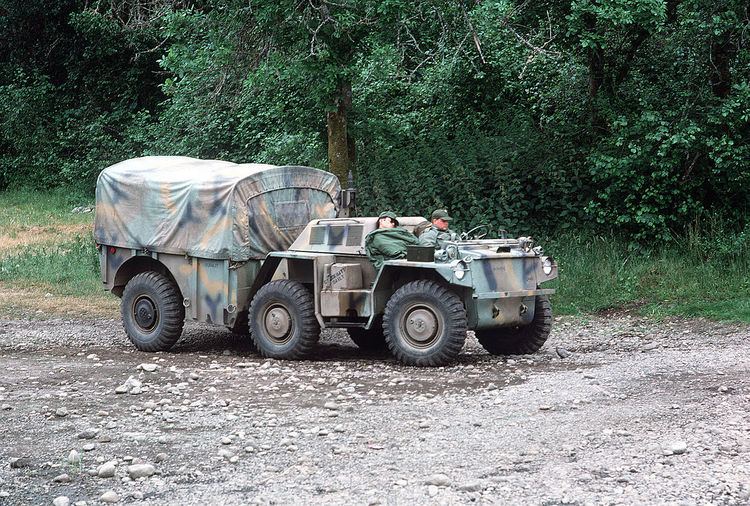Type 6×6 Cargo In service 1970s–1990s Designer Chance-Vought Aircraft | Designed 1962–1966 | |
 | ||
The Gama Goat was a six-wheel drive semi-amphibious off-road vehicle originally developed for use by the US military in the Vietnam War. The 'Goat used an articulated chassis, so that from distance it appears to be a four-wheel drive vehicle pulling a two-wheel trailer, but it is a single six-wheel vehicle with a four-wheel steering arrangement with the front and rear wheels turning in opposite directions. It was famous for its ability to travel over exceptionally rough and muddy terrain.
Contents
The vehicle's nickname came from two sources; "Gama" from the name of the inventor of its powered articulated joint, Roger Gamaunt, and "Goat" for its mountain goat-like off-road ability. Its military designation was M561, 6×6 tactical 1¼-ton truck. There was also an ambulance version known as the M792. The 'Goat' is prized among military vehicle collectors because it is so unusual and in short supply. The vehicle was replaced by a variety of Commercial Utility Cargo Vehicles (CUCV) and "Humvees" (HMMWV)
History
The concept for the vehicle came when the French Army reported that the United States Army trucks provided to them were woefully inadequate for the terrain in Vietnam. In 1959, ARPA (now known as DARPA) funded a research project called Project "Agile" to develop a new tactical truck for the Southeast Asia theatre, as well as other projects of interest to the then-looming Vietnam War.
Several companies bid for the contract, including Clark, General Motors and LeTourneau, but the contract was awarded to Ling-Temco-Vought (LTV) aerospace, best known for their A-7 Corsair II aircraft. Final construction of the vehicles was conducted by the Consolidated Diesel Electric Company (CONDEC) at their factory in Charlotte, North Carolina. CONDEC also had factories in Schenectady, New York, where the Gama Goat was originally manufactured, and in Greenwich, Connecticut, where the parts for the Gama Goat were produced. In the early 1960s, the company moved to Waterbury, Connecticut for a few years, then closed their plants in New York and Connecticut to move to Charlotte, North Carolina for cheaper labor and facilities.
The Gama Goat was replaced by a variety of CUCVs and "Humvees" (HMMWV).
Description
Overall, some 14,274 Gama Goats were built at a cost of US$8,000 each (1965 dollars; equivalent to $60,798 in 2016); this was considered quite high at the time. 12,516 were slated for the US Army and 1,758 or the USMC. While the Gama Goat had exceptional off-road ability, its quirky steering made it hard to handle on pavement, and its tendency to flounder in amphibious operations required drivers to have special training in order to operate it. This meant that it could not be the "general purpose" vehicle the Army had hoped for, and production was halted after the original contract expired. This is somewhat ironic, as some claim that the problems were largely due to cost-cutting modifications made at the request of the United States Army.
The air-cooled engine used in the original prototypes overheated in use, and was replaced in the production vehicles with a liquid-cooled Detroit 3-53 Diesel engine. Due to the high-intensity noise from the two-stroke Diesel engine, the drivers required hearing protection. The double hull construction and complex articulated drivetrain made maintenance difficult (the lubrication order alone took around six hours). In service in Vietnam, Gama Goats would often be sent out ahead of other vehicles in order to arrive at their destination at the same time.
While technically listed as amphibious, the Gama Goat's swimming capability was limited to smooth water crossings of ponds, canals and streams due to the very low freeboard and the lack of a propeller. Propulsion in the water was supplied by the six spinning wheels, and bilge pumps were standard equipment. Drivers had to remember to close the hull's drain openings before swimming the vehicles. Some models had extra equipment installed that made them too heavy to swim, such as heavy-duty winches, communications shelters that made them top heavy, or radar gear.
It was designed to be air-transportable and droppable by parachute.
